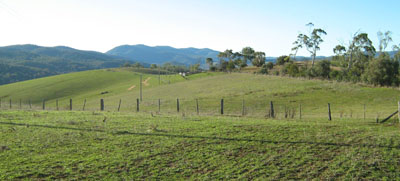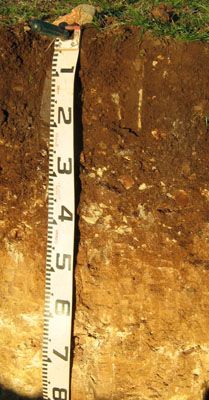EGC217
Location: Buchan
Australian Soil Classification: Melanic, Calcic, Red DERMOSOL
Map Unit: Buchan (Component 1)
Previous Site Name: EG217
General Landscape Description: Rolling hills
Site description: Upper slope, 5% slope, western aspect
Land Use: Grazing
Native Vegetation: Grassy woodland
Geology: Devonian limestone, Taravale Formation

Soil Profile Morphology:
| Surface soil
|
 | ||
| A1 | 0 – 20 cm | Dark reddish brown (5YR3/2); heavy clay loam (subplastic); strong fine (2 – 5 mm) granular structure; few (2 – 10%) subrounded limestone pebbles (6 – 20 mm); weak consistence moist; clear change to: | |
| Subsoil
| |||
| B21 | 20 – 40/50 cm | Dark reddish brown (5YR3/4); medium clay; strong fine (5 – 10 mm) polyhedral structure; common (10 – 20%) subangular limestone pebbles (20 – 60 mm); very firm consistence moist; clear and wavy change to:
| |
| B22 | 40/50 -60 mm | Light brown (7.5YR6/4) mottled with strong brown (7.5YR5/6); silty clay; weak medium (10 – 20 mm) polyhedral structure; few (2 – 10%) subangular limestone pebbles (20 – 60 mm); firm consistence dry; clear change to:
| |
| C | 60 – 100 mm | White (7.5YR8/1), soft limestone; few (2 – 10%) subangular limestone pebbles (20 – 60 mm); limestone becoming stronger with depth |
Key Profile Features:
- Lack of texture contrast between the surface (A) horizon and the subsoil (B) horizon.
- Moderately shallow profile depth to limestone.
Soil Profile Characteristics:
| - | pH | Salinity | |
Surface soil (A1 horizon) | Slightly Alkaline | Very Low | Non Sodic |
Subsoil (B21 horizon) | Moderately Alkaline | Very Low | Non Sodic |
Deeper subsoil (60-100 cm) | Strongly Alkaline | Very Low | Non Sodic |
Chemical and Physical Analysis:
Horizon | Horizon Depth (cm) | pH (water) | pH (CaCl2) | EC dS/m | Organic Carbon % | Total Nitrogen % | Exchangeable Aluminium ppm | Exchangeable Cations | Coarse Sand (0.2-2.0 mm) % | Fine Sand (0.02-0.2 mm) % | Silt (0.002-0.02 mm) % | Clay (<0.002 mm) % | Field Capacity % w/w | Wilting Point % w/w | |||
Ca | Mg | K | Na | ||||||||||||||
meq/100g | |||||||||||||||||
A1 | 0-20 | 7.7 | 7.2 | 0.08 | 4.3 | 0.36 | <10 | 38 | 0.99 | 0.52 | 0.17 | 3 | 9 | 23 | 49 | 38.5 | 22.8 |
B21 | 20-40/45 | 8.2 | 7.6 | 0.06 | 2.2 | 0.17 | <10 | 34 | 0.6 | 0.38 | 0.13 | 8 | 9 | 14 | 37 | 33.4 | 18.8 |
B22 | 40-60 | 8.6 | 7.8 | 0.04 | 0.51 | <0.05 | <10 | 25 | 0.22 | <0.05 | 0.13 | 12 | 16 | 9 | 26 | 34.2 | 14.7 |
C | 60-100 | 8.8 | 7.8 | 0.03 | 0.31 | <0.05 | <10 | 24 | 0.28 | <0.05 | 0.11 | 19 | 9 | 8 | 16 | 36.3 | 10.4 |
Management Considerations
Whole profile
- Plant available water (PAW) here is considered to be moderate, estimated to be 90 mm. Because of the variability in the depth of soil cover within this map unit, many soils will have low to very low water-holding capacity. Effective rooting depth is limited to the depth to rock.
Surface (A) horizons
- The surface soil here is slightly alkaline and no response to additional lime would occur.
- The soils are low in soluble salts.
- Potassium levels are moderate and plant responses to potassium fertiliser are unlikely given the present grazing management.
- The nutrient holding capacities of the surface (A1 and B21) horizons are high (based on the sum of the exchangeable calcium, magnesium, potassium and sodium cations).
Subsoil (B) horizons
- The subsoil is well drained as there is no sharp increase in clay content at the A/B boundary.
- The subsoil horizons are non-sodic and strongly structured, which will enable plant roots to penetrate easily until they reach decomposing limestone that acts as both a physical and chemical barrier.


